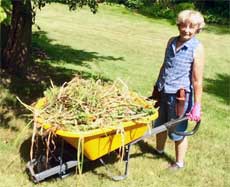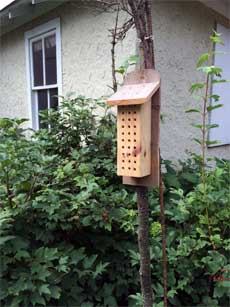The weather cleared up and was very pleasant for the June meeting at the Kruse garden. Members strolled through the garden, John the tool sharpener was very busy honing our garden tools, and Tracy made three beautiful floral arrangements.
July in the Kruse garden is a month to be enjoyed. Though we do weeding, dead-heading, watering, planting is mostly finished, moving plants can wait for September. This is the time to admire our results. And the colors are beautiful. It is the month for daylilies, zinnias, daisies, many cone flowers. The hydrangeas are blooming. We take longer breaks, our work is more relaxed, we view color combinations and possible improvements, look for monarch butterflies on the milkweed. We saw a humming bird. If a Wednesday is missed due to rain, there is usually no great urgency for a make-up date.
Since I have all this space to write in and I have taken care of what we are doing at the garden now, I would like to tell you about a gardening book I have been reading, a few pages at a time–The Year at Great Dixter’ by Christopher Lloyd. Great Dixter is a beautiful home and garden in England, the garden started by Lloyd’s parents than improved upon by Lloyd over many years. It is visited by thousands of people yearly. Lloyd has been dead for ten years and the garden is maintained now by other landscapers. The book is a yearly journal of what he planted, wants to plant, and how his garden is doing. Even if I don’t know many of the plants, trees, and shrubs he talks about, it is fun to read—especially that everything he tries is not always successful, some plantings fail, some look awful. He includes a few recipes—I am going to try making his elderberry cordial.
I have gleaned a few interesting planting ideas from some of the pages that I’ve read. For instance I absolutely love oriental poppies, but I plant only a few because after the blooms, the foliage is large and lasts a long time in a sorry browning state. Now Lloyd says he cuts the foliage to the ground after blooming. Of course I immediately got my clippers and clipped my two down to the ground. Then I looked at the bare spot and wondered if my garden has the same conditions as his—will my poppies come back? He plants his poppies with bearded iris and particularly loves the orange ones. I like the orange poppies too—old standbys, remembered from grandmother’s garden, so vibrant in the sun. There is one that I particularly admired in the catalogues called Patty’s Plum—a large one having a real purple color. Wouldn’t it look striking with a yellow bearded iris? And then be able to cut the poppy to the ground after bloom? When our garden club took the Cantigny tour, I noticed a beautiful Siberian iris—Pink Haze—featured in one of the garden rooms. It would also look wonderful with a purple poppy.
Lloyd has a great liking for Verbena bonariensis, which is also a great favorite of mine. He plants it with variegated grasses, which I think might work well at the Kruse garden—we have the Japanese variegated silver grass. The verbena around it might give a wonderful effect. He uses many plants that we all probably have in our gardens but he uses them in many very interesting ways. And I have to admit it is perversely pleasant sometimes to read how miserable the weather is in some months at Great Dixter and how drafty and cold that huge house can be.
“A Year at Great Dixter” are monthly musings from a true gardener, Christopher Lloyd, his joy at the beauty of plants, his honest opinion on care and thoughts on trees, shrubs and everything in between. -Angie



 - Membership
- Membership